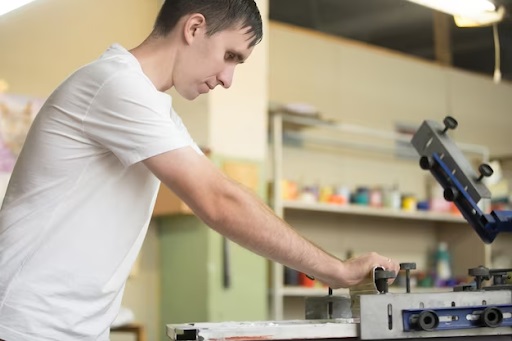The fashion landscape is in the midst of a notable transformation. As consumers increasingly seek unique and personalized clothing, the popularity of handcrafted fashion is on the rise. One aspect of this surge is the growing appreciation for custom screen-printed apparel.
This unique printing technique offers a canvas for self-expression, personal branding, and creativity, making it a pivotal player in the evolution of the fashion industry.
In this article, we will explore the resurgence of custom screen printing and its role in the handcrafted fashion movement. We’ll delve into the history, process, and appeal of this art form, and we’ll examine why it is becoming an increasingly popular choice for consumers and businesses alike.
The Craft of Screen Printing
Screen printing, also known as silk screen printing, is an age-old technique that has stood the test of time. It has its roots in ancient China, where stencils were used to transfer ink onto fabric.
The process has evolved significantly over the centuries, with the most significant development being the use of screens made of silk, which allowed for more intricate and detailed designs.
The essence of screen printing remains the same: a design is transferred to a mesh screen, with portions of the screen blocked off to prevent ink from passing through. The screen is then pressed against the fabric, transferring the ink and creating the desired design.
The Appeal of Custom Screen Printing
The resurgence of custom screen printing in the modern fashion landscape can be attributed to several key factors:
- Unique Personalization: Custom screen printing offers a level of personalization that other printing methods struggle to match. From slogans and messages to intricate artworks, the possibilities are virtually endless. This level of customization enables individuals, as well as companies like Custom Tees ATL, to express their personality and values through their clothing, creating a profound connection between wearers and their attire.
- Durability: Screen printing creates prints that are known for their longevity. The ink is heat-cured into the fabric, resulting in designs that withstand numerous washes and maintain their vibrancy. This durability is a significant selling point for those seeking high-quality, long-lasting apparel.
- Artistic Expression: Screen printing is an art form in itself. The process allows for fine details, vibrant colors, and a tactile quality that is distinct from other printing techniques. Artists and designers are drawn to the medium for its capacity to translate their creative vision onto fabric.
- Versatility: Screen printing is not limited to t-shirts; it can be applied to a wide range of apparel and accessories. From hoodies and hats to tote bags and posters, the potential applications of screen printing are diverse.
- Eco-Friendly Options: The rise of eco-conscious consumers has led to the development of eco-friendly inks and sustainable practices in screen printing. Water-based inks and responsible sourcing of materials are becoming increasingly prevalent, appealing to environmentally conscious individuals.
A Journey Through History
Screen printing has a rich history in the realm of art, design, and fashion. In the early 20th century, it gained prominence as a method for producing posters, signage, and promotional materials. During the 1960s and 1970s, it became a key component of the counterculture and was widely used in political protests and the art world.
The technique gained significant attention in the fashion industry during the same period, with the rise of the DIY (do it yourself) movement and the popularization of graphic tees. Bands, artists, and entrepreneurs began using screen printing to create custom t-shirts with bold, eye-catching designs.
The handcrafted and unique nature of these creations was a stark contrast to the mass-produced fashion items of the time.
In the decades that followed, screen printing became a means of expressing individuality and capturing cultural moments. It was also embraced by businesses and organizations for promotional materials and branded apparel.
The ability to produce high-quality, long-lasting prints made screen printing an enduring choice for many applications.
The Role of Screen Printing in Handcrafted Fashion
- The resurgence of custom screen printing aligns with the broader movement toward handcrafted fashion. This trend reflects a growing desire for authenticity and uniqueness in clothing.
- Consumers are seeking items that tell a story, are imbued with individuality, and reflect their personal tastes and values.
- Screen printing embodies the essence of handcrafted fashion. Each print is a product of skilled craftsmanship, requiring careful attention to detail and precision.
- The hands-on nature of the process, from creating screens to aligning and applying the design, lends a personal touch to every piece of apparel.
- Additionally, screen printing allows for smaller production runs, making it well-suited to boutique brands, independent designers, and small businesses.
- These creators can experiment with designs, respond quickly to market trends, and offer limited-edition items, all of which resonate with consumers seeking unique fashion choices.
- In the era of fast fashion, where mass production often sacrifices quality and individuality, screen printing brings an element of slow fashion.
- Slow fashion encourages mindful consumption, valuing the longevity and emotional connection that comes with well-crafted, custom pieces.
The Business of Custom Screen Printing
- The resurgence of custom screen printing is not limited to the consumer market. Businesses and organizations have recognized the potential of screen printing for branding and promotion. Custom screen-printed apparel serves as a versatile and memorable marketing tool.
- Companies, both small and large, use custom screen printing to create branded merchandise, such as t-shirts, hoodies, and hats. These items are given away or sold as a means of building brand recognition and fostering a sense of community among customers and employees.
- For events, custom screen-printed apparel adds a unique touch. Whether it’s for a corporate gathering, a sports team, or a charity fundraiser, custom screen-printed shirts can serve as mementos and foster a sense of unity among participants.
- Custom screen printing also plays a crucial role in the music and entertainment industry. Bands and artists often offer custom screen-printed merchandise at concerts and online stores, allowing fans to connect with their favorite musicians and wear their allegiance proudly.
Technology and the Digital Age
- While custom screen printing is rooted in tradition, it has not remained static in the face of technological advancements. The digital age has brought new tools and techniques that complement and enhance the screen printing process.
- The use of computer-aided design (CAD) software has streamlined the design phase, allowing for precise image creation and manipulation. This digital approach can result in greater efficiency and accuracy in translating designs to screens.
- Additionally, digital technology has enabled the creation of high-resolution, full-color designs that were once challenging to achieve with traditional screen printing methods. Innovations such as digital screen-making processes and direct-to-screen imaging have revolutionized the way screens are prepared, enhancing the quality and speed of screen printing.
- Furthermore, the integration of e-commerce and online marketplaces has made it easier than ever for consumers to access custom screen-printed apparel. Individuals can browse a vast array of designs, select their favorite, and place an order with a few clicks.
Sustainability and Screen Printing
As sustainability becomes a focal point in the fashion industry, screen printing has adapted to align with eco-conscious consumer values. The process of screen printing can be made more sustainable through various means:
- Eco-Friendly Inks: The use of water-based inks, which are less harmful to the environment than solvent-based alternatives, is becoming more common in screen printing. Water-based inks produce less air pollution and are easier to dispose of safely.
- Responsible Material Sourcing: Many screen printers are sourcing eco-friendly and organic materials for their apparel, further reducing the environmental impact of their products.
- Recycling and Reclaiming: Screen printers are implementing practices to reduce waste and pollution, such as recycling screens and reclaiming ink for future use.
- Local and Small-Batch Production: By emphasizing small-batch and local production, screen printers can reduce the carbon footprint associated with shipping and large-scale manufacturing.
- Educating Consumers: Some screen printers are taking an active role in educating consumers about sustainable choices in apparel, empowering them to make environmentally responsible decisions.

Conclusion
The growing popularity of custom screen printing is not merely a fashion trend but a reflection of a broader shift in consumer values. It aligns with the desire for authenticity, uniqueness, and sustainability in clothing. Handcrafted fashion, exemplified by screen printing, is gaining momentum as consumers seek items that resonate with their individuality and values.
Screen printing’s rich history, craftsmanship, and versatility make it an attractive choice for individuals and businesses alike. It provides an avenue for artistic expression, personal branding, and meaningful connections with audiences. In a world where mass production and disposable fashion often dominate, custom screen printing offers a counterbalance, emphasizing quality, individuality, and lasting value.

